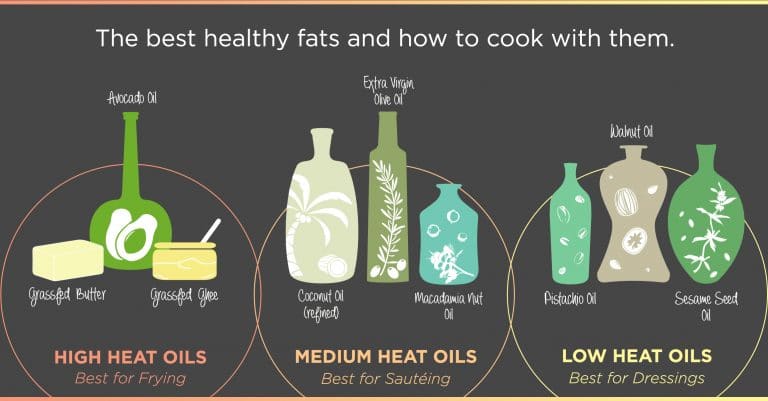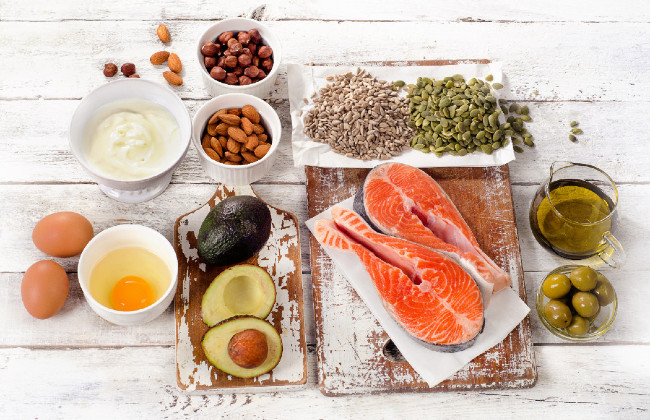With enough butter, anything is good. – Julia Child
The beloved French chef was right. Fats do make foods taste better. But most importantly, they are imperative to good health.
At the most basic level, healthy fats contribute to our cellular structure. They are the building blocks for strong cell membranes and the hormones that regulate most of our body’s processes. We need healthy fats to create the appropriate structure at the cellular level, which will in turn support the proper functioning of our bodies.
What Are Some of the Functions of Fat in the Body?
- Fats provide a stable, dense source of energy
Fats are satiating and provide needed energy in the form of calories. They are a concentrated source of energy with more than twice as many calories per gram as either proteins or carbohydrates. Unlike fast‑burning carbohydrates, fats are a long, slow-burning, efficient source of energy. They are the main fuel for our muscles, including the heart.
- Fats promote optimal functioning of the liver and gallbladder
Fats trigger the liver to produce bile, a substance made from cholesterol that is necessary for emulsifying fat and making it easier to digest. Bile from the liver is stored and concentrated in the gallbladder. The presence of fats in the body triggers the gallbladder to release bile into the small intestines to complete digestion of the fats. However, if we don’t eat fats or eat poor quality fats, the bile becomes too thick to pass through the ducts of the gallbladder, causing the bile to become trapped, which can lead to inflammation and the formation of gallstones.
- Fats are required for the proper absorption of our fat-soluble vitamins A, D, E, and K
Dietary fat, which comes from the food that we eat, is necessary for the proper absorption of vitamins A, D, E, and K, which are stored in the liver and fatty tissues. Unlike the water-soluble vitamins B and C, the fat-soluble vitamins cannot “dissolve” in water. Each fat-soluble vitamin promotes a different function in the body, with vitamin A supporting vision and a healthy immune system, vitamin D contributing to bone maintenance and immune system support, vitamin E acting as an antioxidant to destroy free radicals, and vitamin K playing an important role in blood clotting and reducing the build up of calcium in the blood. If these vitamins are consumed in the absence of fats then we cannot utilize or store them properly, which ultimately leads to deficiencies.
- Fats form a protective lining around our organs and help to regulate body temperature
The body has a layer of fat that surrounds our major organs, including the brain and heart, nerves, tissues, and bones. It acts like a cushion that absorbs shock and protects our essential organs from significant damage in cases of sudden impact or severe trauma. Also, the thin layer of fat under the surface of our skin insulates the body, helping us to maintain our body temperature and protecting our internal organs from extreme temperature changes.
- Fats slow the absorption of food, helping to regulate appetite and energy needs
Fats are key in helping to regulate our blood glucose levels. Consuming carbohydrates, especially those that are highly processed and full of refined sugar, cause rapid spikes in blood sugar. Our bodies respond by releasing insulin, which causes our blood sugar levels to fall abruptly. These sharp spikes and drops in blood sugar and insulin result in energy crashes, food cravings, especially for more refined carbohydrates and caffeine to counteract the fatigue, and weight gain. Over time, the overproduction of insulin will lead to insulin resistance, chronically high blood sugar, and possibly diabetes. Fats do not affect insulin levels like carbohydrates or protein. And, because they take longer to digest, including fats with carbohydrates at meals can help to delay or slow down your digestion, leading to a slower absorption of carbohydrates, which results in more stable blood glucose levels throughout the day.
- Fats are required for the body to inflame and anti-inflame
The process of inflammation in the body is controlled by prostaglandins. Prostaglandins are hormone-like substances produced from the fats that we consume; Omega 3 and Omega 6 polyunsaturated fats produce anti-inflammatory prostaglandins while saturated fats produce inflammatory prostaglandins. Although it might appear that polyunsaturated fats are better than saturated fats because they are responsible for reducing inflammation, saturated fats are equally as important because they create the inflammation that the body needs to heal. And, to properly heal, the body needs to first inflame before it can anti-inflame.
- Fats are important for brain and nerve health
Fats provide the structural components for various cell membranes in the brain. They also create the structural components for the fatty sheath called myelin that surrounds and insulates our nerve fibers, helping to communicate and carry messages more quickly.
Not All Fats Are Created Equal
Despite the important roles that fats play in promoting good health, many people still struggle with including them in their diets. And understandably so. Because for decades the medical community and media endorsed low-fat, high carbohydrate foods, claiming that the incidence of heart disease would be dramatically reduced if we were to remove saturated fats and cholesterol from our diets. Even though our ever-declining health should be the proof needed to discredit the low-fat phenomena, some people are still skeptical. And while I am not recommending that we eat fats with abandon to the point of excluding proteins and carbohydrates, I am suggesting that we strike a reasonable balance between all of our macronutrients, as each contributes uniquely to our health. And while fats are critical for proper structure and function, we need to be mindful that not all fats are created equal, and some fats are so unhealthful that they need to be avoided completely.
In general, fats are organic (living) molecules that are made up of carbon atoms. These carbon atoms are held together by single and/or double bonds and are arranged in chains that vary in length and shape. The type of bond determines how many hydrogen atoms can attach to the structure. Fats are named based on the degree of saturation (the amount of hydrogen) and the length of their carbon chains.
Saturated Fats
Saturated fats have no double bonds in their chemical structure, meaning that they are completely saturated (full) with hydrogen atoms. This makes them solid or semisolid at room temperature. Saturated fats do not go rancid easily and can withstand high heat, making them a perfect option for cooking at higher temperatures.
Monounsaturated Fats
These fats have 1 double bond. This makes them less stable than saturated fats but more stable than polyunsaturated fats. They do not go rancid easily even when unrefrigerated but should only be used for light sautéing. They are also known as Omega 9s.
Polyunsaturated Fats
Polyunsaturated fats have 2 or more double bonds, which makes them the least stable of the fats. They are always liquid at room temperature and are very susceptible to light and heat, both of which cause them to go rancid quite easily. For this reason, polyunsaturated fats should never be used for cooking.
There are 2 types of polyunsaturated fats: Omega 3 and Omega 6. Neither of these can be made by the body so they need to be obtained from our food. There is the general misconception that Omega 3s are the “good” type and Omega 6s are the “bad” type. This is not true. There is nothing inherently good or bad about either one, it is just that they are out of balance. The optimal ratio of Omega 6 to Omega 3 should be 1 to 1. However, most Americans eat a very highly processed and refined diet and these foods contain significant amounts of Omega 6, in the form of poor-quality vegetable oils and hydrogenated fats. As a result, it is not uncommon for the ratio of Omega 6 to Omega 3 to be as high as 20 to 1, and this imbalance leads symptoms of poor health, giving Omega 6 its bad reputation.
Vegetable Oils, Hydrogenated Oils, and Trans Fats
Polyunsaturated vegetable oils are most usually obtained from seeds and beans like corn, sunflower, soybean, and rapeseed (ie, canola oil). Oftentimes, these seeds are genetically modified and contain high levels of pesticides. To obtain the oil from the seeds and beans, the manufacturers use high heat, high pressure, and chemicals such as hexane to optimize the extraction process. These delicate oils are often so rancid that they then have to be deodorized with chemicals to remove the horrible odor before they can be bottled for sale. Worse yet, they are most often bottled in clear containers and placed on supermarket shelves under bright lights with no temperature control, causing them to oxidize further. As a result, consumption of these oils is not recommended.
The only way to improve the shelf life of these delicate oils is to alter them chemically through the process of hydrogenation. To initiate this process, a metal such as nickel or aluminum is added to the polyunsaturated oil. Hydrogen ions are pumped at high speeds, high temperatures, and high pressure into the oils causing the metals to bond with the fat, changing its structure so that it resembles a saturated fat. Although the resulting product is now stable and solid at room temperature (think Crisco), it has also been chemically altered into the “trans” formation, otherwise known as trans fats. The resulting fat is gray in color and has a putrid smell due to the hydrogenation process. So, to make it acceptable for human consumption, it is processed further with bleaching and deodorizing chemicals, and sometimes even colors and flavors are added as is the case with margarine.
Trans fats are not naturally occurring in nature. They deceive the body and replace the healthy fats in our cell membranes. And, as we discussed at the beginning, when our cell membranes are compromised, this causes dysfunction at the cellular level, which then results in dysfunction in the body, leading to the development of chronic illnesses, including hormone imbalances, inflammation, and diseases of the gallbladder, immune, and cardiovascular systems, to name a few.
Safe Fats and How to Use Them

Saturated fats are derived primarily from animal sources (tallow and suet) and tropical oils. Healthy sources come from pasture-raise animals, organic virgin coconut oil, and organic palm oil.
Olive oil and avocado oil are monounsaturated fats that can be used for cooking. They should be organic, cold-pressed, unrefined, and packaged in dark bottles. Other healthy sources include olives and avocados (as the whole fruits), almonds and almond oil, hazelnuts and hazelnut oil, macademia nuts and macademia oil.
Polyunsaturated fats most often come from nuts and seeds. They contain high amounts of Omega 6s so they should be consumed sparingly. The majority are best used as finishing condiments or as an ingredient in salad dressings and should never be heated. Healthy sources of Omega 6s include blackcurrant seed oil, evening primrose oil, sunflower oil, sesame oil, flaxseed oil, pistachio nuts, pumpkin seeds, and sunflower seeds.
Flax seeds and oils from fish (cod liver oil) are a good sources of Omega 3s. It is recommended that they are consumed in moderation to maintain balance with Omega 6s. They should be stored in dark bottles in the refrigerator, however, they do not store well for long periods of time. Other healthy sources of Omega 3s are mackerel, salmon oil, walnuts, chia seeds, herring, salmon (wild caught), tuna, white fish, sardines, anchovies, natto, and pasture-raised egg yolks.
Vegetable oils, hydrogenated oils, and trans fats do not support good health and should never be consumed.
As you can see, there are a variety of healthy fats that can be used safely for cooking. So put the olive oil back on the shelf and give some of these other options a try! Just be sure to use them at the specified temperatures to ensure that they maintain all of their healthful qualities.




